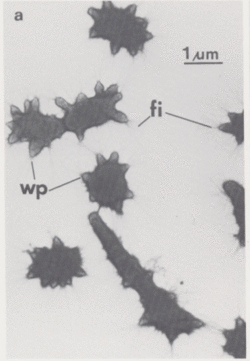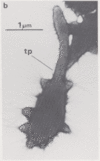Verrucomicrobium
A Microbial Biorealm page on the genus Verrucomicrobium

Classification
Higher order taxa:
Bacteria; Chlamydiae/Verrucomicrobia group; Verrucomicrobia; Verrucomicrobiae; Verrucomicrobiales; Verrucomicrobiaceae
Species:
Verrucomicrobium spinosum, Verrucomicrobium sp.
Description and Significance
The prosthecobacterium (having multiple appendages on its cell surface) Verrucomicrobium is an obscure bacterium found in eutrophic ponds and lakes.
Genome Structure
There is currently a genome project taking place on Verrucomicrobium spinosum DSM 4136, it has a G-C content of about 57.9-59.3 mol%.
Cell Structure and Metabolism
Verrucomicrobium spinosum are heterotrophic, Gram-negative, nonmotile bacteria with appendages called prosthecae that can be wart-like or long and extended in shape. The wart-like prosthecae are an average of 0.5 micrometers in length, and the less-common, extended prosthecae are generally up to 2 micrometers long. Some prosthecae have bundles of fimbriae extruding from their tips. V. spinosum is facultatively anaerobic and can ferment sugars without making gas as a product; however, V. spinosum can not reduce nitrate anaerobically (Prokaryotes). V. spinosum also can not grow on amino or organic acids, only sugars. V. spinosum also contains menaquinones. A related bacterium, strain VeGlc2 of the order Verrucomicrobiales, was shown to ferment glucose to acetate, propionate, succinate, and CO2 through the Embden-Meyerhof-Parnas pathway (Janssen 1998).
Ecology

Not much is known about the natural environments where Verrucomicrobium and other prosthecate bacteria live. Verrucomicrobium sp. has been found in eutrophic ponds and lakes such as ones in parks where visitors commonly feed waterfowl; Verrucomicrobium has a low salinity tolerance. In the lab, V. spinosum grow best at tempuratures between 26oC and 33oC with a maximum growth tempurature at 34oC.
